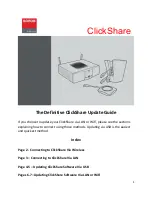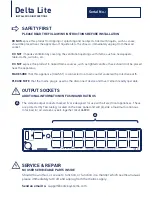
Section 3: Operation
3-40 Christie DS+60/DW30/Matrix 3000 User’s Manual
WARP LATENCY:
Set the percentage of frame delay (default = 50.0) desired for
displaying incoming data. A higher or lower setting will typically be needed with
significant warps, ensuring that all of the image appears. Warp latency also provides a
means of synchronizing one display with adjacent displays or other equipment such as
audio.
NOTE: If a ChristieTWIST
module is installed, the Edge Blending menu controls
are expanded to include user-defined blends appropriate for a warped image. The
new blend ranges are 0-80 for side blends, and 0-60 for top or bottom blends. If no
warping is currently applied but you still need to use edge blending for a tiled wall,
select “Standard”.
Keystone
This option is available when the ChristieTWIST
module is not installed.
Use to correct a keystoned image shape in which both sides of the image are inclined
toward the top or bottom edge. Keystone is typically caused by tilting the projector in
relation to the screen so that the lens surface and screen are no longer parallel to each
other. (Figure 3.18)
Figure 3.18.
Brightness Uniformity
— SUBMENU
Brightness Uniformity provides further refinement of displays already matched for
their primary colors and overall light output. Use Brightness Uniformity to create an
exceptionally smooth image in which no area appears brighter and/or more red, green
or blue than another. In the Brightness Uniformity menu, enable the “Uniformity
Enable” checkbox to access a multitude of adjustments for critical color light output
control in specific areas throughout the image. Your settings apply as long as the
“Uniformity Enable” checkbox is enabled and you are using a “User” color
temperature defined by the Brightness Uniformity controls. To disable the Brightness
Uniformity function, delete the “Uniformity Enable” checkmark.
NOTE: See also 3.10, Using Multiple Projectors for the complete step-by-step
procedure for achieving uniform brightness in adjacent displays.
Edge Blending
— SUBMENU
The Edge Blending submenu provides a range of controls for smoothing together the
overlapping bright edges of multiple adjacent projected images to create a single
larger “seamless” image. These controls, which primarily affect whitelevels, are
typically used in conjunction with mechanical lens blinders (optional), which are
installed on the front of the projector and which primarily affect blacklevels. NOTE:
There is a center line (both horizontal and vertical) in the Edge Blending test pattern.
The intersection of these lines is the true center of the projector’s display area.
NOTE: See also 3.10, Using Multiple Projectors.
















































